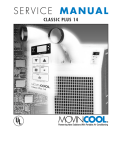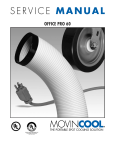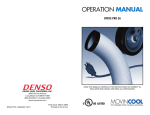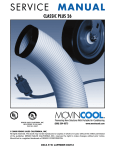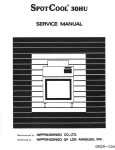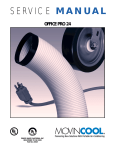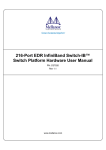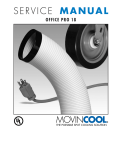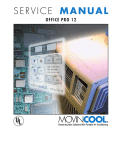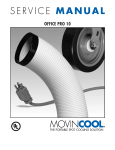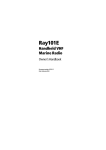Download Movincool 24HFU-1 Service manual
Transcript
SERVICE M A N U A L 24HFU and 24HFU-1 DENSO SALES CALIFORNIA, INC. REGISTERED TO ISO 9002 FILE NO. A5537 (800) 264-9573 www.movincool.com © 2000 DENSO SALES CALIFORNIA, INC. All rights reserved. This book may not be reproduced or copied, in whole or in part, without the written permission of the publisher. DENSO SALES CALIFORNIA, INC. reserves the right to make changes without prior notice. MovinCool is a registerd trademark of DENSO CORPORATION. DSCA P/N: LA990009-0205-E FOREWORD This manual has been published to service the MovinCool 24HFU and 24HFU-1. Both the Model 24HFU and 24HFU-1 perform the same basic function, however the 24HFU-1 has additional features. Please use this service manual in servicing Models 24HFU and 24HFU-1. DEFINITION OF TERMS WARNING Describes precautions that should be observed in order to prevent injury to the user during installation or unit operation. CAUTION Describes precautions that should be observed in order to prevent damage to the unit or its components, which may occur during installation or unit operation if sufficient care is not taken. NOTE Provides additional information that facilitates installation or unit operation. GENERAL PRECAUTIONS WARNINGS: • All electrical work if necessary, should only be performed by qualified electrical personnel. Repair to electrical components by non-certified technicians may result in personal injury and/or damage to the unit. All electrical components replaced must be genuine MovinCool, purchased from an authorized reseller. • When handling refrigerant, always wear proper eye protection and do not allow the refrigerant to come in contact with your skin. • Do not expose refrigerant to an open flame. • The proper electrical outlet for MovinCool units must be equipped with a “UL” approved ground-fault breaker to prevent electrical shock from the unit. • When brazing any tubing, always wear eye protection and brazing tubing in a well ventilated area. MOVINCOOL 24HFU / 24HFU-1 SERVICE PAGE 2 GENERAL DESCRIPTION Generally speaking conventional air conditioners cool the entire enclosed environment. They act as “heat exchangers”, requiring an interior unit (evaporator) to blow cool air into the interior and an exterior unit (condenser) to exhaust exchanged heat to the outdoors. Unlike conventional air conditioners, the MovinCool Spot Cooling System is a spot cooler which directs cool air to particular areas or objects. MovinCool Spot Cooling Systems have the following features: 1-1. Compact Design The innovative design of MovinCool has resulted in one compact unit, replacing the need for two separate units. ■ Conventional Air Conditioner 1-2. Easy Transportation and Installation With the whole cooling system built into one compact unit, MovinCool requires no piping and can be easily transported and installed. 1-3. Energy Conservation MovinCool is economical because it cools only the area or objects which need to be cooled. ■ Air Flow of MovinCool Spot Cooling System MOVINCOOL 24HFU / 24HFU-1 SERVICE PAGE 3 CONSTRUCTION AND SPECIFICATIONS ■ Construction of Models 24HFU & 24HFU-1 MOVINCOOL 24HFU / 24HFU-1 SERVICE PAGE 4 CONSTRUCTION AND SPECIFICATIONS 2-1. Basic Construction The MovinCool Spot Cooling System is compact in construction because the condenser and the evaporator are enclosed in one unit. The interior is divided into three sections. The upper front face is equipped with the evaporator, while the lower front face contains the drain tank. The rear section contains the condenser, the compressor and the control box. 2-2. Air Flow Air drawn from the right side face passes through the condenser and extracts the heat. This hot air is blown out through the upper exhaust air duct. Air taken in from the front face is cooled by the evaporator and then blown through the cooling air duct which can be turned in any direction. All the air inlets are provided with filters, while the exhaust air duct is protected by wire mesh. ■ Air Flow 2-3. Compressor and Fans The compressor is hermetically sealed. One motor is used with two centrifugal fans to draw air across the evaporator and condenser. 2-4. Drain Tank The capacity of the drain tank is 5.3 gallons (20 liters). The unit is equipped with a full tank lamp and a device to automatically stop the unit’s operation when the drain tank reaches a level of approximately 4.4 ± 0.5 gallons (16.5 ± 2 liters). MOVINCOOL 24HFU / 24HFU-1 SERVICE PAGE 5 CONSTRUCTION AND SPECIFICATIONS ITEM/MODEL [Rating Condition] [Features] Power frequency ___________ (Hz) Line voltage ______________ (Volt) Power consumption ________ (Kw) Current consumption _______ (Amp) Power factor ______________ (%) Starting current ____________ (Amp) Power wiring ______________ (AWG) [Cooling Unit] Cooling capability __________ (Kcal/h) ________________________ (Btu/h) Cooling system [Blower] Type of fan Condenser - Air flow ________ (ft3/min) Evaporator - Air flow ________ (ft3/min) Motor output ______________ (Kw) [Compressor] Type Output ___________________ (Kw) Refrigerant type Refrigerant amount _________ (kg) ________________________ (lbs) [Safety Device] Compressor overload relay Fan motor protector Drain switch Anti-freezing thermostat High pressure switch Restart relay - power interruption Time delay relay [Dimensions and Weight] W x D x H ________________ (mm) ________________________ (inch) Weight ___________________ (kg) ________________________ (lbs) [Operating Conditions] Intake air temperature range [Control Device] Temperature control ■ Specifications MOVINCOOL 24HFU / 24HFU-1 SERVICE 24HFU DB 35˚C 95˚F WB 28.2˚C 83˚F RH 60% 24HFU-1 DB 35˚C 95˚F WB 28.2˚C 83˚F RH 60% 60 Single phase 230 3.1 14.0 96 62 12 (3-core) 60 Single phase 230 3.1 14.0 96 62 12 (3-core) 6,000 24,000 Direct expansion 6,000 24,000 Direct expansion Centrifugal fan 1,200 706 0.55 Centrifugal fan 1,200 706 0.55 Hermetic scroll 1.6 R-22 0.85 1.87 Hermetic scroll 1.6 R-22 0.85 1.87 With With With With With Without Without With With With With With With With 490 x 730 x 1200 19.3 x 28.7 x 47.2 107 235 490 x 730 x 1200 19.3 x 28.7 x 47.2 107 235 45˚C (113˚F), RH ≤50% to 25˚C (77˚F), RH ≥50% 45˚C (113˚F), RH ≤50% to 25˚C (77˚F), RH ≥50% Without With Specifications are subject to change without notice. PAGE 6 REFRIGERANT SYSTEM The component parts of the refrigerant system include the following: • Compressor • Condenser • Capillary tube • Evaporator • High pressure switch • Modulating tank These parts are all connected by copper piping. All the connections have been brazed. Condenser Modulating Tank Evaporator Compressor Capillary Tube High Pressure Switch ■ Refrigerant System MOVINCOOL 24HFU / 24HFU-1 SERVICE PAGE 7 REFRIGERANT SYSTEM 3-1. Compressor The compressor used for the unit is hermetically sealed. The compressor and the compressor motor are in one casing. 3-1-1. Compressor Theory of Operation The scroll utilizes an involute spiral which, when matched with a mating scroll form, generates a series of crescent-shaped gas pockets between the two members. During compression, one scroll remains stationary (fixed scroll) while the other form (orbiting scroll) is allowed to orbit (but not rotate) around the first form. As this motion occurs, the pockets between the two forms are slowly pushed to the center of the two scrolls while simultaneously being reduced in volume. When the pocket reaches the center of the scroll form, the gas, which is now at a high pressure, is discharged out of a port located at the center. During compression, several pockets are being compressed simultaneously, resulting in a very smooth process. Both the suction process (outer portion of the scroll members) and the discharge process (inner portion) are continuous. 3-1-2. Compressor Operation 1) Compression in the scroll is created by the interaction of an orbiting spiral and a stationary spiral. Gas enters the outer openings as one of the spirals orbits. 2) The open passages are sealed off as gas is drawn into the spiral. 3) As the spiral continues to orbit, the gas is compressed into two increasingly smaller pockets. MOVINCOOL 24HFU / 24HFU-1 SERVICE PAGE 8 REFRIGERANT SYSTEM 4) By the time the gas arrives at the center port, discharge pressure has been reached. 5) Actually, during operation, all six gas passages are in various stages of compression at all times, resulting in nearly continuous suction and discharge. NOTE Upon compressor shut-off, the compressor may run backward for a moment or two until internal pressures equalize. This has no effect on compressor durability but may cause an unexpected sound after the compressor is turned off and should not be diagnosed as a malfunction. 3-2. Condenser The condenser is a heat exchanger whose copper tubes are covered with thin aluminum projections called spine fins. Heat is given off and absorbed by air being pulled across the condenser fins by the centrifugal fan and then expelled through the exhaust air duct. MOVINCOOL 24HFU / 24HFU-1 SERVICE PAGE 9 REFRIGERANT SYSTEM 3-3. Capillary Tube The capillary tube is a long thin tube and its line flow resistance serves as an expansion valve. The length and the inner diameter of the capillary tube are determined according to the capacity of refrigeration system, operating conditions and the amount of refrigerant. The capillary tube causes the high pressure, high temperature liquid refrigerant sent from the condenser to expand rapidly as the refrigerant is sprayed out through the fixed orifice in the capillary tube. As a result, the temperature and state of the refrigerant become low and mistlike, and therefore it evaporates easily. Qty 1 ■ Capillary Tube Capillary Tube Dimensions Purpose of Use I.D. (mm) Length (mm) For cooling ∅1.5 ± 0.05 540 3-4. Evaporator The evaporator, like the condenser, is a heat exchanger covered with spine fins. Heat is removed from the air being pulled across the evaporator by the centrifugal fan and the resulting cool air is expelled through the cooling air ducts. 3-5. Modulating Tank The modulating tank consists of a copper pipe and tank sections, each being separated from the other. The pipe connects to the evaporator outlet at one end and to the compressor at the other; the tank connects to the evaporator inlet. The modulating tank is covered with insulation to reduce thermal effects of ambient temperature. It varies the quantity of refrigerant in the refrigerating cycle for optimum operating condition; it stores part of refrigerant under light load and delivers additional refrigerant to the cycle under heavy load. ■ Modulating Tank 3-6. High Pressure Switch The high pressure switch prevents the condenser and compressor from being damaged by excessively high pressure in the high pressure line of the refrigeration cycle. The switch is normally closed. The snap disk responds to variations in pressure and, if pressure is abnormally high, the snap disk moves down to push the pin down, causing the internal contacts to open. This generates a signal to open the auxiliary relay. Possible causes of this trouble include: (1) The condenser air filter is dirty, restricting air flow. (2) The condenser blower is defective. MOVINCOOL 24HFU / 24HFU-1 SERVICE ■ High Pressure Switch PAGE 10 REFRIGERANT SYSTEM Condenser Inlet Pipe Compressor Discharge Pipe Condenser Outlet Pipe Evaporator Inlet Pipe Evaporator Outlet Pipe Capillary Tube Connecting Pipe (evaporator to compressor) Compressor Suction Pipe (insulated) Connecting Tube (condenser to capillary tube) ■ Refrigerant System Piping MOVINCOOL 24HFU / 24HFU-1 SERVICE PAGE 11 ELECTRICAL SYSTEM • 24HFU 24HFU ■ Electrical System and Control Box for Model 24HFU MOVINCOOL 24HFU / 24HFU-1 SERVICE PAGE 12 ELECTRICAL SYSTEM • 24HFU 4-1. Basic Operation of MovinCool Modelp 24HFU Electrical Circuit The three basic modes of operation are as follows: ■ Operation in “OFF” position 1) Control Switch in “OFF” position: a. Current flows through terminals 5 and 2 of the control switch (CS) and to the coil of the auxiliary relay (RX). (A and B.) b. Two contacts (RX) of the auxiliary relay are closed by electromagnetic force. The closed contact RX (terminals 19 and 20) allows current to flow directly to the auxiliary relay coil and hold the contact in a closed position. NOTE Symbol indicates alternating current. ■ Operation in “FAN” position 2) Control Switch in “FAN” position: a. Current also flows through the control switch (CS) to the fan motor (MF). b. Current flows through the contact (terminals 19 and 20) of the auxiliary relay and its coil, and remains closed. ■ Operation in “COOL” position 3) Control Switch in “COOL” position: a. The contacts of the auxiliary relay remain closed as mentioned in step 2) b. b. Current flows to the fan motor (MF). c. Current also flows to the anti-freezing thermostat (THS) contact, to the coil of the relay for the compressor motor (MCC) (A and B) and the auxiliary relay contacts. d. Two contacts of the relay for the compressor motor (MCC) are closed by the electromagnetic force. Current then flows to the compressor motor (MC). MOVINCOOL 24HFU / 24HFU-1 SERVICE PAGE 13 ELECTRICAL SYSTEM • 24HFU 4-2. Control Box 4-2-1. Capacitor The capacitor is used to boost power output to the fan motor and the compressor at start-up. The specifications of each capacitor are shown below. Capacitor For fan motor For compressor Registrant Voltage (Volt) 440 370 Capacitance (mF) 12.5 40 4-2-2. Auxiliary Relay This auxiliary relay is normally closed when the unit is in operation (FAN or COOL), and supplies power to the compressor relay and the fan motor. In the following cases, however, the relay opens to interrupt power to the compressor and the fan motor. • When the drain tank is filled with water. (Drain switch OFF.) • When the high pressure becomes excessively high. (High pressure switch OFF.) When current flows across A and B, terminals 11 and 12, 13 and 14, 15 and 16, 19 and 20 conduct. Specifications: Rated Voltage Rated current UL Listed File No. ■ Auxiliary Relay AC 240V 15 amps E112482 4-2-3. Compressor Relay The compressor relay is closed when the unit is operating in COOL mode, and supplies power to the compressor. However in the following cases, the relay opens to cut off power to the compressor. • When the auxiliary relay is opened. (Drain switch OFF or high pressure switch OFF.) • When the evaporator has frosted. (Thermostat OFF.) Specifications: Rated Voltage Rated Current UL Listed File No. ■ Circuit of Auxiliary Relay ■ Circuit of Compressor Relay AC 230V 30 amps E43028 ■ Compressor Relay MOVINCOOL 24HFU / 24HFU-1 SERVICE PAGE 14 ELECTRICAL SYSTEM • 24HFU 4-3. Control Switch The control switch is employed to start or stop operation. This switch is a 250V, 20A rating rotary type (3-position). The switching positions are OFF-FAN-COOL. Each contact is switched by the cam uniting with the shaft. Switch Terminals (5) - (2) (5) - (1) (5) - (4) OFF Conduct OFF OFF FAN OFF Conduct Conduct COOL OFF OFF Conduct ■ Control Switch 4-4. Fan Motor The fan motor is a single phase, induction type motor which drives fans on the evaporator side and the condenser side at the same time. CF1 CF2 RX12 ■ Fan Motor Specifications: Rated Voltage Rated Output UL Listed File No. AC 230V 552 Watts E49807 4-5. Compressor Motor The compressor motor is a single phase motor and is contained within the same housing as the compressor. Specifications: Rated Voltage Rated Output AC 230V 1600 Watts NOTE An internal overload relay is used to protect the compressor motor and fan motor. This relay is built into the compressor motor and fan motor and will interrupt the flow of current when there is an overcurrent situation or if abnormally high temperature builds up in the compressor motor or fan motor. 4-6. Anti-freezing Thermostat If the evaporator has frosted, the thermostat contacts open to stop the compressor and the unit continues to operate on “FAN” mode. Once the evaporator has defrosted, the contacts close to restart the compressor and the unit operates in “COOL” mode. The thermostat heat sensing tube is mounted at the evaporator outlet tube and is insulated from surrounding air by heat insulating material. The thermostat contacts are opened at -1.5˚C and closed at +14.5˚C. ■ Thermostat MOVINCOOL 24HFU / 24HFU-1 SERVICE PAGE 15 ELECTRICAL SYSTEM • 24HFU 4-7. Drain Switch The drain switch interrupts both the compressor motor circuit and the fan motor circuit when the drain water accumulates approximately 4.4 gallons (16 liters) in the drain tank. This also illuminates the full tank lamp on the control panel and stops the operation. This system adopts a 250V, 3A rating micro switch for this function. When drain water accumulates approx. 4.4 gallons (16 liters) in the drain tank, the drain tank base plate, which is supported at its fulcrum (a), is pushed down in the arrow direction as shown in the figure below. When the drain tank base plate is forced down, “portion A” located at the top of the drain tank base plate turns off the contacts (1) - (2) of the micro switch. Since this breaks the auxiliary relay (RX) circuit, the auxiliary relay contacts are turned off to break the compressor circuit and the fan motor circuit. At the same time, the contacts (1) - (3) are turned on to light the full tank warning lamp. ■ Operation of Drain Switch When the drain tank is removed (or the water in the drain tank is drained), portion “A” of the drain tank base plate returns to its original position by the elasticity of the coil spring. Then the contacts (1) - (3) turn off, extinguishing the full tank lamp. At the same time, the contacts (1) - (2) turn on. Under this condition, turn the control switch to FAN or COOL position to start operation. 4-8. Condensate Pump Kit <OPTIONAL> Models 24HFU and 24HFU-1 come standard with a condensate tank, which collects the water that forms on the evaporator during normal cooling operation. If the unit is required to operate continuously without periodic emptying of this tank, a condensate pump may be needed. A condensate pump kit is available for Models 24HFU and 24HFU-1. MOVINCOOL 24HFU / 24HFU-1 SERVICE PAGE 16 ELECTRICAL SYSTEM • 24HFU 4-9. Wiring 24HFU ■ Wiring Diagram for Model 24HFU MOVINCOOL 24HFU / 24HFU-1 SERVICE PAGE 17 ELECTRICAL SYSTEM • 24HFU-1 24HFU-1 ■ Electrical System and Control Box for Model 24HFU-1 MOVINCOOL 24HFU / 24HFU-1 SERVICE PAGE 18 ELECTRICAL SYSTEM • 24HFU-1 UNIQUE FEATURES OF MOVINCOOL 24HFU-1 The MovinCool 24HFU-1 is a modified version of Model 24HFU. Model 24HFU-1 has several additional features, which are described below. 4-1. Automatic Restart After Power Interruption A restart auxiliary relay has been added to the electrical system to allow automatic restarting of the system after a power interruption, eliminating the need for manual reset of the control switch. Specifications: Rated Voltage Rated Current UL Listed File No. AC 240V 10 amps E57520 4-2. Compressor Protection There is a time delay circuit included in the electrical system to prevent a heavy load from being applied on the compressor motor when restarting the system. This delay is in effect any time when the compressor is turned on, by the control switch, thermostatic control, or resumption after blackout. (This delay is also in effect when automatic restart after power interruption operates.) Delay time 75 ± 15 seconds. Specifications: Rated Voltage In Operation After Operation Relay Time UL Listed File No. AC 240V 3 amps 13 amps 75 ± 15 sec. E41515 MOVINCOOL 24HFU / 24HFU-1 SERVICE PAGE 19 ELECTRICAL SYSTEM • 24HFU-1 4-3. Temperature Control The compressor is controlled by a thermostat which senses the return air temperature. This thermostat can be set to approximate temperatures by means of the thermostat dial, located below the control switch. 1 LESS COOL → 7 COOLEST Specifications: Rated Voltage Rated Current Off Diff UL Listed File No. AC 240V 20 amps (Power Factor COS r = 1) 16.1 ± 1.1 (˚C) 2.8 ± 1.1 (˚C) (ON: 18.9 (˚C)) SA512 4-4. Fan Mode Control Switch The fan motor is controlled by a switch located in the control box. There are two positions: A. COOL-OFF When the switch is set to the left, the fan motor is controlled by the thermostat which controls the compressor. In this case, both the fan and the compressor stop when the thermostat detects sufficiently low intake air temperature. When the temperature increases again, the fan will restart automatically. The fan motor is independent from the time delay circuit which protects the compressor, consequently the fan will begin approximately 75 seconds before the compressor restarts. B. COOL-FAN When the switch is set to the right, the fan motor will be controlled only by the control switch. As long as the unit is set to FAN or COOL, the fan will operate continuously. (This is the factory default setting.) Specifications: Rated Voltage Rated Current UL Listed File No. AC 250V 16 amps E98133 CAUTION Because there is a built-in delay circuit to protect the compressor, the compressor will never start up immediately, regardless of the type of operation. This delay is part of the normal operation of Model 24HFU-1 and should not be diagnosed as a malfunction. MOVINCOOL 24HFU / 24HFU-1 SERVICE PAGE 20 ELECTRICAL SYSTEM • 24HFU-1 4-5. Compressor Motor Relay Specifications: Rated Voltage Rated Current UL Listed File No. AC 230V 30 amps E43028 4-6. Condensate Pump Kit <OPTIONAL> Models 24HFU and 24HFU-1 come standard with a condensate tank, which collects the water that forms on the evaporator during normal cooling operation. If the unit is required to operate continuously without periodic emptying of this tank, a condensate pump may be needed. A condensate pump kit is available for Models 24HFU and 24HFU-1. MOVINCOOL 24HFU / 24HFU-1 SERVICE PAGE 21 ELECTRICAL SYSTEM • 24HFU-1 4-7. Wiring 24HFU-1 ■ Wiring Diagram for Model 24HFU-1 MOVINCOOL 24HFU / 24HFU-1 SERVICE PAGE 22 DATA 24HFU ■ Exterior Dimensions of Models 24HFU & 24HFU-1 MOVINCOOL 24HFU / 24HFU-1 SERVICE PAGE 23 DATA 24HFU Blower Housing (Evaporator) Side Panel High Pressure Switch Hot Air Outlet Evaporator Fan Condenser Side Panel Full Tank Lamp Upper Panel Fan Motor Cooling Air Duct Blower Housing (Condenser) Evaporator Drain Pan Drain Tube Conduit Control Switch Thermostat Condenser Fan Modulating Tank Air Filter (Condenser) Front Panel Capillary Tube Service Panel Air Filter (Evaporator) Compressor Control Box Drain Switch Rear Panel Castor Drain Tank Power Cord Castor Base Panel ■ Construction Diagram of Models 24HFU & 24HFU-1 MOVINCOOL 24HFU / 24HFU-1 SERVICE PAGE 24 DATA Models 24HFU & 24HFU-1 5-1. Cooling Capability Characteristics 1) Cooling capability curve ■ Cooling Capability Curve Models 24HFU & 24HFU-1 2) Power consumption curve ■ Power Consumption Curve MOVINCOOL 24HFU / 24HFU-1 SERVICE PAGE 25 DATA 3) Cool air temperature difference curve Models 24HFU & 24HFU-1 ■ Cool Air Temperature Difference Curve MOVINCOOL 24HFU / 24HFU-1 SERVICE PAGE 26 REPAIR - TROUBLESHOOTING Before troubleshooting this system, the following inspection should be performed. 1-1. Inspection of Power Source Voltage Check the voltage of the power source. 24HFU & 24HFU-1: Single phase 230 volts (60Hz) Check the operation and condition of the fuse or circuit breaker in the power source. 1-2. Inspection of Air Filters Remove the air filters and check the element. If it is dirty, wash it as described in the OPERATION MANUAL supplied with the unit. 1-3. Inspection of Drain Tank Be sure tank is fully drained. The following chart is provided as a guide for categorized problem remedies. Detailed information is contained in the OPERATION MANUAL supplied with the unit. TROUBLE SYMPTOM POSSIBLE CAUSE REMEDY Unit does not operate Unit does not operate 1) 2) 3) 1) 2) 3) 1) 2) 3) 1) 2) Refer to 4-2 Refer to 4-1 Refer to 4-5 Refer to Wiring Diagram Refer to 4-6 Refer to 4-7 Refer to 4-7 Refer to Wiring Diagram Refer to 4-10 Repair Repair or replace Unit starts, but stops immediately Unit operates, but stops after a few minutes Water leakage from the unit Abnormal noise and shaking Insufficient velocity of cooled air Insufficient cooling Cooled air does not come out 1) 2) 3) 4) 1) 2) 3) Compressor and 1) fan motor rotate 2) properly 3) 4) Compressor motor 1) does not rotate 2) 3) 4) 5) 6) 7) 8) Blower motor does 1) not rotate 2) 3) 4) Defective control switch Defective auxiliary relay Defective drain switch Defective overload relay Defective fan motor Defective compressor motor Defective compressor motor Defective overload relay Defective high pressure switch Defective drain pan (crack or hole) Defective drain hose (clogged or loose connection) Loose compressor mounting nut Deformed or worn rubber grommet on the compressor mounting bolt Interference with other materials. Interference of fan and scroll Clogged spine fin and/or air filter Defective fan motor Defective fan motor capacitor Abnormal environment condition Clogged spine fin Leak in system Clogged refrigerant system Defective compressor motor Defective compressor capacitor Defective auxiliary relay Defective control switch Defective overload relay Defective wiring connection Defective thermostat Defective compressor relay Defective fan motor Defective fan motor capacitor Defective wiring connection Defective auxiliary relay Tighten Replace Remove it Readjust Refer to 2-1 and/or wash the air filter Refer to 4-6 Refer to 4-3 Refer to 2-2 Refer to 2-1 Refer to 5-1 Refer to 5-1 Refer to 4-7 Refer to 4-3 Refer to 4-1 Refer to 4-2 Refer to Wiring Diagram Check and correct Refer to 4-9 Refer to 4-11 Refer to 4-6 Refer to 4-3 Refer to 4-8 Refer to 4-1 ■ TroubleShooting Chart MOVINCOOL 24HFU / 24HFU-1 SERVICE PAGE 27 REPAIR - INSPECTION OF UNIT In case of trouble, perform the following inspection before disassembly. 2-1. Inspection of Spine Fins To inspect the spine fins of either the evaporator or condenser you must remove the air filters. After removal of the air filters, inspect the spine fins for any dirt, dust, lint, or debris that may have caused poor cooling performance of the unit. If cleaning of the spine fins is necessary, it is recommended that this service be performed by a qualified service technician. ■ Spine Fins 2-2. Examination of Operating Environment Operating environments will vary depending on location, climate and surrounding conditions. Installation location also can cause operational problems. Consult your reseller concerning operational environment requirements. ■ Operating Environment 2-3. Inspection of Cooling Capacity Measure the difference in temperature between the inlet of the evaporator and the cooling air duct. If the difference is out of the range given in the graphs on page 27 and 28 proceed with the remedy suggested in the troubleshooting chart on page 31. ■ Inspection of Cooling Capacity MOVINCOOL 24HFU / 24HFU-1 SERVICE PAGE 28 REPAIR - DISASSEMBLY 24HFU 1. 2. 3. 4. 5. 6. 7. 8. 9. 10. Control Switch Upper panel Right side panel Air filter Blower housing (condenser) Condenser fan Rear panel Drain switch Caster Full tank lamp 11. 12. 13. 14. 15. 16. 17. 18. Cooling air duct Front panel Blower housing (evaporator) Drain pan Left side panel Drain tank Service panel Thermostat ■ Disassembly of Models 24HFU & 24HFU-1 MOVINCOOL 24HFU / 24HFU-1 SERVICE PAGE 29 REPAIR - DISASSEMBLY 3-1. Removal of Outer Panels A) Remove the following parts: 1. Air filters 2. Cooling air ducts 3. Drain tank 4. Front panel 5. Rear panel 6. Rear service panel 7. Left side panel ■ Removal of Panels B) Disconnect the three lead wires of the power cord from the control box. Loosen the two screws securing the wire clamp and then remove the power cord. ■ Removal of Power Cord MOVINCOOL 24HFU / 24HFU-1 SERVICE PAGE 30 REPAIR - DISASSEMBLY 3-2. Removal of Electrical Parts 3-2-1. For Model 24HFU disconnect the electrical wiring from the components indicated in the diagram below. 24HFU ■ Wiring Diagram for Model 24HFU MOVINCOOL 24HFU / 24HFU-1 SERVICE PAGE 31 REPAIR - DISASSEMBLY 3-2-1. Continued For Model 24HFU-1 disconnect the electrical wiring from the components indicated in the diagram below. 24HFU-1 ■ Wiring Diagram for Model 24HFU-1 MOVINCOOL 24HFU / 24HFU-1 SERVICE PAGE 32 REPAIR - DISASSEMBLY 3-2-2. Remove the electrical parts in the control box. 24HFU 24HFU-1 ■ Removal of Electrical Parts in the Control Box 3-2-3. Remove the control switch and full tank lamp as shown in figure. ■ Removal of Control Switch MOVINCOOL 24HFU / 24HFU-1 SERVICE PAGE 33 REPAIR - DISASSEMBLY 3-3. Removal of Blower Assembly ➇ ➀ 1. 2. 3. 4. ➁ ➂ Condenser fan Blower housing (condenser) Fan motor Motor bracket ➄ ➃ 5. 6. 7. 8. ➅ ➆ Partition plate Evaporator fan Blower housing (evaporator) Air flow guide ■ Disassembly of Blower MOVINCOOL 24HFU / 24HFU-1 SERVICE PAGE 34 REPAIR - DISASSEMBLY 3-3-1. Remove the set bolt using a box wrench and then remove the centrifugal fan. ■ Removal of Blower Screw 3-3-2. Remove two nuts as depicted. Also remove two screws which fasten the upper panel. Then remove the blower housing (condenser). A - NUT B - SCREW ■ Removal of Nut 3-3-3. Remove two nuts and two screws as depicted. Then remove the motor bracket together with the fan motor. A - NUT B - SCREW ■ Removal of Nut 3-3-4. Remove the centrifugal fan by loosening the set bolt on the shaft. Remove the blower motor, by loosening “A” nuts. ■ Removal of Fan MOVINCOOL 24HFU / 24HFU-1 SERVICE PAGE 35 REPAIR - INSPECTION AND REPAIR OF ELECTRICAL SYSTEM • 24HFU 24HFU 4-1. Inspection of Auxiliary Relay Check for continuity across the terminals when the test button is depressed and when it is released. Terminals 11-12 13-14 15-16 19-20 State of Reset Switch Depressed Released Depressed Released Depressed Released Depressed Released Continuity Conduct Not Conduct Conduct Not Conduct Conduct Not Conduct Conduct Not Conduct Measure the resistance across terminals A and B. Standard resistance: 1900~2100 Ω When the resistance is out of this range, replace the auxiliary relay. ■ Inspection of Auxiliary Relay 4-2. Inspection of Control Switch At each position of the control switch, there should be continuity across the following terminals. Switch Position Conducting Terminals OFF 2-5 FAN 1-5 COOL 1 - 5, 4 - 5 If there is no switch continuity, replace the control switch. 4-3. Inspection of Capacitor (for Fan Motor and Compressor) Set the ohmmeter to 100 KW range. Place two probes against the two terminals of the capacitor. At first, the ohmmeter should indicate 0 Ω, then the meter reading should gradually approach infinity. If the ohmmeter indicates infinity from the first or the meter reading fails to move from 0 Ω, replace the capacitor. WARNING Before and after testing the capacitor for the fan motor and compressor, proper discharging of electrostatic charge should be performed by a qualified service technician. Improper discharge of the capacitor can cause electrical shock or death. MOVINCOOL 24HFU / 24HFU-1 SERVICE ■ Inspection of Control Switch ■ Inspection of Capacitor PAGE 36 REPAIR - INSPECTION AND REPAIR OF ELECTRICAL SYSTEM • 24HFU 4-4. Inspection of Full Tank Warning Lamp Make a test circuit as shown. If the lamp fails to light up, replace it. ■ Inspection of Full Tank Warning Lamp 4-5. Inspection of Drain Switch Check for continuity between terminals 1 and 2. Continuity should exist. With switch depressed, continuity should exist between terminals 1 and 3. If continuity is not as specified above, replace the switch. ■ Inspection of Drain Switch 4-6. Inspection of Fan Motor Measure resistance across the terminals of the fan motor. Terminals CF2 - RX12 CF1 - RX12 CF1 CF2 RX12 Approx. 12.5Ω Approx. 6.53Ω At 25˚C (77˚F) If the measured resistance is not equal to these standard values, replace the fan motor. ■ Inspection of Fan Motor 4-7. Inspection of Compressor Motor Measure resistance across the terminals of the compressor motor. Terminals R-C C-S S-R ■ Inspection of Compressor Motor MOVINCOOL 24HFU / 24HFU-1 SERVICE Approx. 0.94Ω Approx. 1.96Ω Approx. 2.90Ω At 25˚C (77˚F) If the measured resistance is not equal to these standard values, replace the compressor. The compressor has a built-in overload relay. The overload relay should be operational if the above resistance is obtained under normal temperature. PAGE 37 REPAIR - INSPECTION AND REPAIR OF ELECTRICAL SYSTEM • 24HFU 4-8. Inspection of Wiring Connection Refer to the Wiring Diagrams 3-2-1. (pg. 35 and 36) and check for connection of each wire. 4-9. Inspection of Anti-freezing Thermostat Check for continuity across two terminals of the thermostat. At normal temperature (17˚C/63˚F or higher), there is continuity across two terminals. If continuity is interrupted across the terminals, replace the thermostat. ■ Inspection of Thermostat 4-10. Inspection of High Pressure Switch Check for continuity across two terminals of the high pressure switch. With pressure equalized when the unit is stopped, there is continuity across two terminals. If continuity is interrupted across the terminals, replace the high pressure switch. Specifications: Cut off pressure - 29.5kg/cm2G (420 PSIG) Reset pressure - 20.5kg/cm2G (291 PSIG) 4-11. Inspection of Compressor Relay Check for continuity across the terminals when the test button is depressed and when test button is released. ■ Inspection of High Pressure Switch Depressed: Continuity exists between each pair of opposing terminals Released: No continuity exists between each pair of opposing terminals Measure the resistance across terminals A and B. Standard resistance: 650~800 Ω When the resistance is out of this range, replace the compressor relay. MOVINCOOL 24HFU / 24HFU-1 SERVICE ■ Inspection of Compressor Relay PAGE 38 REPAIR - INSPECTION AND REPAIR OF ELECTRICAL SYSTEM • 24HFU-1 24HFU-1 UNIQUE FEATURES OF MODEL 24HFU-1 4-1. Inspection of Time Delay Relay Check for continuity between terminals 1 and 9, and 4 and 12. Continuity should exist. With rated voltage applied at terminal 13 and 14 (and after a time delay of 75 seconds) continuity should exist between terminals 5 and 9, and 8 and 12. Delay time 75 ± 15 seconds. If continuity does not exist as specified, replace the time delay relay. ■ Inspection of Time Delay Relay 4-2. Inspection of Restart Auxiliary Relay Check for continuity between terminals 1 and 5. Continuity should exist. With rated voltage applied at terminals 7 and 8, continuity should exist between terminals 3 and 5. If continuity does not exist as specified, replace the restart auxiliary relay. ■ Inspection of Restart Auxiliary Relay MOVINCOOL 24HFU / 24HFU-1 SERVICE PAGE 39 REPAIR - INSPECTION AND REPAIR OF ELECTRICAL SYSTEM • 24HFU-1 4-3. Inspection of Room Thermostat Check for continuity between terminals 2 and 3, at room temperature (16˚C/61˚F or higher). Continuity should exist. If continuity does not exist, replace the room thermostat. ■ Inspection of Room Thermostat 4-4. Inspection of Fan Mode Control Switch Check for continuity between pins 1 and 2 (when switch is set to the left as shown) and pins 1 and 3 (when switch is set to the right). If continuity is not as specified, replace the fan mode control switch. ■ Inspection of Fan Mode Control Switch 4-5. Inspection of Compressor Relay Check for continuity across the terminals when the test button is depressed and when test button is released. Depressed: Continuity exists between each pair of opposing terminals. Released: No continuity exists between each pair of opposing terminals with the exception of terminals 11 and 12. (Continuity should always exist.) Measure the resistance across terminals A and B. Standard resistance 650 ~ 800 Ω. If resistance is out of range or if continuity is different than specified, replace the compressor relay. ■ Inspection of Compressor Relay MOVINCOOL 24HFU / 24HFU-1 SERVICE PAGE 40 REPAIR - INSPECTION AND REPAIR OF REFRIGERANT SYSTEM 5-1. Inspection In most cases, the probable cause for insufficient cooling is a clogged system, leakage or an incorrect amount of refrigerant. In such cases, inspect the system according to the following procedure. 5-1-1. Inspection of Clogged System Check the component parts of the refrigerant system, including piping, that could be clogged with refrigerant. If clogged with refrigerant, only the clogged part is frosted partially. In such a case, change the part in question. 5-1-2. Inspection of Refrigerant Leak Carefully check all connections, and each component for leaks whenever the refrigerant system is installed or repaired. Use an electronic gas leak tester to inspect the system. 5-1-3. Insufficient Refrigerant In case the unit is judged to be deficient in cooling capacity, be sure to perform the inspections in 5-1-1. and 5-1-2. to confirm the cause of trouble. After that, charge the system with refrigerant. 5-2. Repair of Refrigerant System In case there is a leak, obstruction, or trouble in the refrigerant system of the Spot Cooling System, replace or repair the part in question. After replacing any component all connections must be brazed. 5-2-1. Proper Brazing Techniques It is desirable to use a slightly reducing flame. Oxyacetylene is commonly used since it is easy to judge and adjust the condition of the flame. Unlike gas welding, a secondary flame is used for brazing. It is necessary to preheat the base metal properly depending on the shape, size or thermal conductivity of the brazed fitting. The most important point in flame brazing is to bring the whole brazed fitting to a proper brazing temperature. Care should be taken to not cause overflow of brazing filler metal, oxidization of brazing filler metal, or deterioration due to the overheating of flux. (1) BRAZED FITTING AND ITS CLEARANCE In general, the strength of brazing filler metal is lower than that of the base metal. So, the shape and clearance of the brazed fitting are quite important. As for the shape of the brazed fitting, it is necessary to maximize its adhesive area. The clearance of the brazed fitting must be minimized to facilitate brazing filler metal to flow into it by capillary action. ■ Brazed Fitting and its Clearance (2) CLEANING OF BRAZING FILLER METAL AND PIPE When the refrigerant system has been opened up, exposure to heat may have caused brazing filler metal to stick to the inside and outside of the pipe. Brazing filler metal may also be compounded with oxygen in the air to form oxide film. Fats and oils may stick to the pipe from handling. All these factors will reduce effectiveness of brazing. It is necessary to eliminate excess brazing filler metal using sand paper and by cleaning thoroughly with a solvent such as Trichlene. MOVINCOOL 24HFU / 24HFU-1 SERVICE PAGE 41 REPAIR - INSPECTION AND REPAIR OF REFRIGERANT SYSTEM (3) USE OF DRY NITROGEN GAS During brazing, the inside of the pipe undergoes an oxidative reaction due to the brazing flame. Introduce dry nitrogen gas (1l/min.; adjust with the flow regulator) through the pinch-off tube of the refrigerant cycle to prevent oxidation. NOTE Take care not to allow dirt, water, oil, etc. to enter into the pipe ■ Vertical Down Joint (4) VERTICAL JOINT Heat the whole brazed fitting to a proper brazing temperature. Bring the brazing filler metal into contact with the fitting so that the brazing filler metal starts flowing by itself. Stop heating the fitting as soon as the brazing filler metal has flown into the clearance. Since the brazing filler metal flows easily into the portion heated to a proper temperature, it is essential to keep the whole fitting at a proper brazing temperature. ■ Vertical Up Joint 5-2-2. Removal of Refrigerant Cycle Components CAUTION 1.Before any refrigerant cycle component can be replaced, it is necessary to recover the refrigerant using standard recovery procedures and equipment. 2.To prevent oxidation, dry nitrogen should be conducted (flow rate 1l/min) through the pinchoff tube during any brazing operation. 3.During any component replacement involving brazing, shield nearby parts with a steel plate, asbestos, etc., to protect them from the flame. 1. 2. 3. 4. Evaporator Capillary tube Condenser Compressor NOTE Hold the compressor body, not the tube, when carrying the compressor. ■ Removal of Refrigerant Cycle Components MOVINCOOL 24HFU / 24HFU-1 SERVICE PAGE 42 REPAIR - INSPECTION AND REPAIR OF REFRIGERANT SYSTEM 24HFU A D F C E B Removal of Refrigerant Cycle Components (Refer to 5-2-2.) PART REPLACED Compressor Condenser Capillary tube Evaporator DISCONNECT AT: A&B A&C D&E E&F ■ Refrigerant Cycle MOVINCOOL 24HFU / 24HFU-1 SERVICE PAGE 43 REPAIR - INSPECTION AND REPAIR OF REFRIGERANT SYSTEM 5-3. Charging the System with R-22 Refrigerant Always ensure that the refrigerant system has been properly evacuated before charging with the specified amount of R-22. WARNING 1) When handling refrigerant (R-22), the following precautions should always be observed: a) Always wear proper eye protection while handling refrigerant. b) Maintain the temperature of the refrigerant container below 40˚C (104˚F). c) Perform repairs in a properly ventilated area. (Never in an enclosed environment.) d) Do not expose refrigerant to an open flame. e) Never smoke while performing repairs, especially when handling refrigerant. f) Be careful the liquid refrigerant does not come in contact with the skin. 2) If liquid refrigerant strikes eye or skin: a) Do not rub the eye or the skin. b) Splash large quantities of cool water on the eye or the skin. c) Apply clean petroleum jelly to the skin. d) Go immediately to a physician or to a hospital for professional treatment. 5-3-1. Connection of Gauge Manifold (1) Properly remove the crushed end of the pinch-off tube at the high pressure side and the low pressure side of the refrigerant cycle with a pipe cutter. (2) Fit the process tube fitting to the pinch-off tube on both sides. ■ Mounting of Process Tube Fitting MOVINCOOL 24HFU / 24HFU-1 SERVICE PAGE 44 REPAIR - INSPECTION AND REPAIR OF REFRIGERANT SYSTEM (3) Connect the charging hoses (red high pressure side, blue - low pressure side) of the gauge manifold to the process tube fittings. NOTE Connect the hoses using care not to mistake the high pressure side for the low pressure side and vice versa. (4) Connect the charging hose (green) at the center of the gauge manifold to the vacuum pump. ■ Connection of Gauge Manifold 5-3-2. Evacuation (1) Open the high pressure valve (HI) and the low pressure valve (LO) of the gauge manifold. (2) Turn on the vacuum pump to start evacuation. (Evacuate the system for approximately 15 minutes.) (3) When the low pressure gauge indicates 750mmHg (30in.Hg) or larger, turn off the vacuum pump and close the high and low pressure valves of the gauge manifold. ■ Evacuation ■ Checking Vacuum 5-3-3. Checking Vacuum (1) Leave the high pressure valve and the low pressure valve of the gauge manifold closed for five minutes or more, and confirm that the gauge pointer does not return to zero. (2) If the gauge pointer returns gradually to zero there is a leak somewhere in the system (this could also include gauge manifold). Perform leak check according to procedure indicated in 5-3-4. Once leak has been found and repaired evacuate the system once more, and confirm system holds vacuum. 5-3-4. Checking Gas Leak (1) Remove the charging hose (green) from the vacuum pump, and connect the hose to the refrigerant cylinder (R22). ■ Evacuating Air Inside Charging Hose MOVINCOOL 24HFU / 24HFU-1 SERVICE PAGE 45 REPAIR - INSPECTION AND REPAIR OF REFRIGERANT SYSTEM (2) Loosen the nut on the gauge manifold side of the charging hose (green). (3) Open the high pressure valve of the gauge manifold. Charge the system with refrigerant until the low pressure gauge indicates 57 PSIG. (4 kg/ cm2G.) After charging is complete, close the high pressure valve. (4) Check carefully for gas leaks inside the refrigerant system using the gas leak tester. (5) Repair any leak. ■ Charging with Refrigerant for Gas Leak Check WARNING Do not attempt any repair on a charged system. 5-3-5. Evacuation (Repeat) (1) Close the valve of the refrigerant cylinder. Then remove the charging hose (green) from the refrigerant cylinder, and connect it to the refrigerant recovery machine. WARNING Before checking for gas leaks, fully confirm that there is nothing flammable in the area to cause an explosion or fire. Contact of refrigerant with an open fire generates toxic gas. NOTE Keep the high pressure valve and the low pressure valve of the gauge manifold closed. (2) Using procedure 5-3-2., evacuate the system until the low pressure gauge indicates 750mmHg (30in.HG) or greater. (For 15 minutes or more.) (3) After evacuation is complete, close the high and the low pressure valves of the gauge manifold. CAUTION Be sure to evacuate the system twice or more using the repetitive vacuum method. Evacuate the system an additional time on rainy or humid days. ■ Evacuation (Repeat) 5-4. Refrigerant Charging Work 5-4-1. Refrigerant Charging (1) Remove the charging hose (green) from the vacuum pump, and connect it to the refrigerant cylinder (R-22). (2) Loosen the nut on the gauge manifold side of the charging hose (green). Open the valve of the charging hose (green). Open the valve of the refrigerant cylinder. ■ Evacuating Air Inside Charging Hose MOVINCOOL 24HFU / 24HFU-1 SERVICE PAGE 46 REPAIR - INSPECTION AND REPAIR OF REFRIGERANT SYSTEM (3) Securely place the refrigerant cylinder on a scale with a weighing capacity of 70 lbs (30 kg) that is graduated by 0.2 oz (5 g). (4) Open the high pressure valve of the gauge manifold and the valve of the refrigerant cylinder. Charge the system with refrigerant to the specified amount. Standard Amount of Refrigerant: ■ Charging with Refrigerant 29.9 oz +0.7 -0.0 oz (1.87 lbs) (850 g +20.0 -0.0 g) If the system cannot be charged with the specified amount of refrigerant under this condition, follow the steps below: a) Close the high-pressure valve of manifold. b) Operate the refrigerant system. c) Slowly open the low-pressure valve while observing the scale reading. d) When the scale reads the specified amount, immediately close the low-pressure valve. e) Bring the system to a stop. CAUTION The amount of refrigerant charged has a great effect on the cooling capacity of the unit. Charge to the specified amount, always observing the scale graduations while charging. (5) Close the high pressure valve of the gauge manifold and the valve of the refrigerant cylinder. 5-4-2. Removal of Gauge Manifold (1) Crimp the pinch-off tube with a pinchoff tool. (2) Remove the gauge manifold and the process tube fitting. Crush the end of the pinch-off tube. (3) Braze the end of the pinch-off tube. (4) Ensure that a gas leak is not present at the pinched off portion and the brazed end. ■ Removal of Gauge Manifold MOVINCOOL 24HFU / 24HFU-1 SERVICE PAGE 47 REPAIR - REASSEMBLY Reassemble the unit in the reverse order of removal. Described below are the parts that require special care in reassembling the unit. Perform all wiring or rewiring as referenced in the wiring diagram. 6-1. Compressor Mounting Mount the compressor on the frame, using cushions, steel collars, spring washers, plate washers and nuts. ■ Compressor Mounting 6-2. Blower Assembly Install blower fans (for evaporator and condenser). Tightening torque: 1.3 ± 0.26 lb-in (1.5 ± 0.3kg-cm) NOTE After reassembling, the gap between blower fan and housing should be 0.06 inches (1.5 mm) or more. ■ Blower Assembly Mounting 6-3. Wiring Notice Secure the wires using clamps so that they do not come into contact with the edges of the structure, etc. Secure the wires using clamps in the same position they were before removal. 6-4. Perform the inspection of cooling capacity and check for abnormal noise or abnormal vibration. MOVINCOOL 24HFU / 24HFU-1 SERVICE PAGE 48
















































